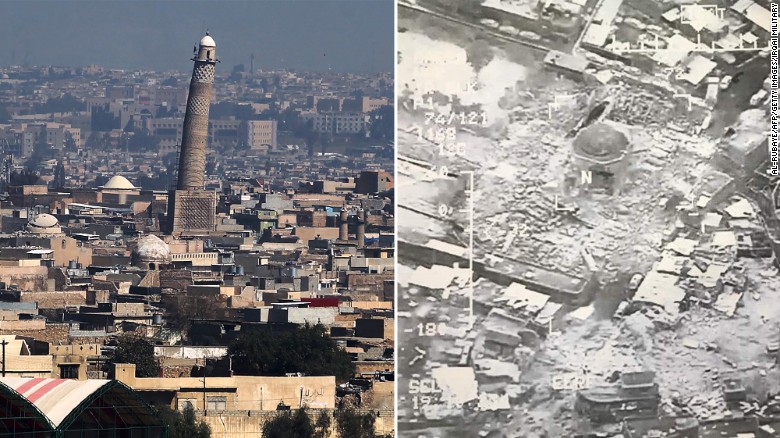The United States and Iraq said ISIS blew up a historic mosque in Mosul that was the ideological heart of the terror group and the birthplace of its self-declared caliphate.
ISIS, through its news agency, said US warplanes were responsible for the loss late Wednesday of the Great Mosque of al-Nuri and its leaning minaret.
US officials told CNN the ISIS claim was “1,000% false.”
Iraq Prime Minister Haider al-Abadi said the ISIS act amounts to “an official announcement of their defeat.” His military commanders said militants blew the mosque up after troops closed in.
It’s difficult to overstate the symbolism of the Old City mosque that has witnessed fierce fighting between ISIS militants and coalition forces determined to liberate what was the country’s second-largest city.

For years, the militant group’s black and white flag fluttered from the minaret, which has risen over the city for 800 years. Now the site has largely been reduced to rubble.
On July 4, 2014, ISIS leader Abu Bakr al-Baghdadi led Friday prayers in the mosque. Shrouded in a black turban and robes, the cleric declared the founding of a new caliphate and called on fellow Sunnis to carry out a holy war.
It was the first and last time the leader of the terrorist group spoke publicly to his followers.
CNN’s Arwa Damon said Baghdadi’s declaration effectively broke down borders between Syria and Iraq, creating a magnet for foreign fighters wanting to join ISIS’ cause.
The Islamic complex has been very much on the mind of the Iraqi forces, who believed taking control of the mosque would be a highly symbolic victory. Federal police earlier this year said they looked forward to praying in al-Nuri — but the resistance continued.
Destruction came as troops moved in
US and coalition officials have observed the mosque for several days and have seen fighters and explosives at the site, several US officials have told CNN in recent days. The Iraqi military said “ISIS terrorist gangs” blew up the mosque as Iraqi forces were approaching.
The situation in Mosul has been desperate. As ISIS is being squeezed into even smaller territory — a handful of neighborhoods and Mosul’s old city — the civilians held hostage are running out of food.
Residents said ISIS fighters have massacred people, young and old, trying to flee.
Damon said about 100,000 terrified civilians remain in the convoluted battlefield.
Lt. Gen. Abdul Ghani al-Assadi, commander of Iraqi counterterrorism, said Wednesday: “We are no more going to drive them out of the Old City; we are going to kill all of them in the coming days.”
American military officials deplored the destruction.
“As our Iraqi Security Force partners closed in on the al-Nuri mosque, ISIS destroyed one of Mosul and Iraq’s great treasures,” said US Maj. Gen. Joseph Martin.
Lt. Gen. Stephen Townsend, the top US commander in the fight against ISIS in Syria and Iraq, said: “I was just in Mosul Wednesday afternoon and close enough to see the mosque and its famous leaning minaret. Little did I know it was for the last time. This is just another example that ISIS is a cruel, heartless and godless ideology that cannot be permitted to exist in this world.”
ISIS’ obliteration of history
ISIS has rampaged through numerous cultural heritage sites in Iraq and Syria. (ISIS is part of a puritanical strain of Islam that considers all religious shrines idolatrous).
Here are a few examples of the decried destruction:
— Fighters destroyed Iraq’s ancient Assyrian city of Nimrud in March 2015.
— Earlier that year, militants shoved stone statues off pedestals in the Mosul Museum and took sledgehammers to them and other artifacts.
— In July 2014, extremists in Mosul destroyed what was believed to be the tomb of Jonah, a key figure in Christianity, Judaism and Islam.
— ISIS fighters earlier this year destroyed part of the historic Roman amphitheater in the ancient Syrian city of Palmyra, according to reports. That followed earlier destruction in the archaeological site.
— Iraq’s Ministry of Tourism and Antiquities said in 2015 that it had received reports the ancient Assyrian capital of Khorsabad had been destroyed.
As reported by CNN
